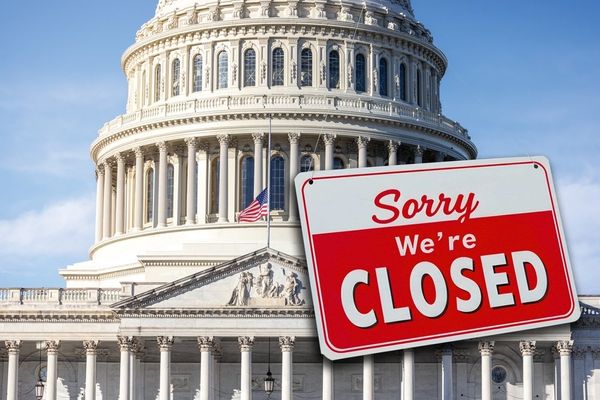
Forget inflation; stagflation is the back-to-the-future buzzword on Wall Street, and it could spell bad news for retirees.
While the U.S. economy isn’t officially in a period of stagflation yet, signs are pointing in that direction. The Gross Domestic Product (GDP) fell 0.3% year-over-year for the first quarter. This period marked the first quarter of negative growth since the first quarter of 2022.
Meanwhile, Federal Reserve Chairman Jerome Powell warned that if the large tariffs instituted by the Trump Administration remain, the U.S. economy could enter a period in which inflation and unemployment are both likely to increase. Powell spoke during the press conference following the May FOMC meeting, in which the central bank held interest rates steady.
“Stagflation is basically higher inflation, combined with stagnant economic growth, combined with increasing unemployment,” says Eric Diton, president and managing director of The Wealth Alliance. “Just looking at the current policy, it’s a legitimate risk.”
Approaching a stagflation economy
There are several warning signs pointing toward a potential stagflation economy.
Take tariffs, for starters. President Trump unveiled sweeping tariffs on most of the world on April 2, announcing a 10% baseline tariff on goods coming into the country. But for many countries, including China, the European Union, Vietnam and Taiwan, tariffs are much higher. Trump did announce a 90-day pause on tariffs shortly thereafter, but economists are still bracing for the economy to take a hit due to the current administration's policies and a potential trade war with China.
A recent Apollo Global Management report warned that the tariffs put in place by President Trump could lead to a recession later this summer. Meanwhile, consumer confidence is plunging along with small business sentiment. At the same time, unemployment is creeping up as companies engage in layoffs. For example, on April 29, UPS announced plans to lay off 20,000 workers and close facilities.
Government spending, which tends to stimulate growth in the economy, is a nonstarter as DOGE seeks to reduce what it calls fraud and waste in the federal government's coffers.
Let's not forget the stock markets and investor portfolios, which are taking a beating, with the Dow Jones Industrial Average, Nasdaq and S&P all set to end April in the red. All of these conditions raise concerns that the U.S. economy could be entering a period of stagflation.
“We’re already seeing indications (of stagflation). I think at this point a key unknown is how long is this going to last and how bad will it eventually get,” says David Blanchett, managing director, portfolio manager and head of retirement research for PGIM DC Solutions.
What stagflation means for retirees
Anyone who lived through the stagflation of the 1970s knows all too well what periods of high inflation and stagnate growth can mean for your pocketbook.
Prices for goods and services rise quickly, eroding consumers’ purchasing power. A sluggish economy could lead to increased layoffs and rising unemployment. For people already in retirement, it could mean a lot of belt-tightening is in the cards.
“Stagflation is a double whammy for retirees, who now have to pay for things (via inflation) and likely have lower savings if the markets continue to do poorly,” says Blanchett.
In periods of stagflation, it can be difficult for retirees to maintain their lifestyles without drawing more money from their retirement savings accounts. With stock markets down, retirees can no longer absorb inflation by relying on rising investment accounts as they did in the past, says Dann Ryan, managing partner at Sincerus Advisory.
Even when inflation was high, retirees had rising stocks to provide a cushion. That meant they could continue to spend at the same rate without worrying about paying more at the grocery store.
“In the past few years, retirees could meet inflation by taking on riskier assets like growth stocks or having higher equity exposures,” says Ryan. “Those opportunities might go away.” After all, stagflation could be bad for both stocks and bonds, he says.
As a result, Ryan says retirees may need to pay more attention to how much they draw down from their retirement accounts; they should make sure they are closer to the 4% withdrawal rate during periods of stagflation. Retirees may also need to rein in their spending and adjust their lifestyle to cope with rising prices for goods and services.
If you are nearing retirement or on the cusp of exiting the workforce, you may want to reconsider that for now, especially if you can continue working. If you plan to work in retirement, Blanchett says to find a job that can cover your bills without needing to access your savings.
The longer you can wait to draw down from your retirement savings account, the better off you’ll be.
How you should approach your portfolio during stagflation
In periods of stagflation, the best way to control risk in your investment portfolio is to be as diversified as possible.
That means spreading your investments across several different assets. Diton says many of his clients' portfolios are either slightly positive or negative year-to-date but are not experiencing the declines seen in the S&P or Nasdaq — because they are well diversified.
“While parts of the markets are down, high dividend stocks like utilities are having a great year. International and emerging markets stocks are dramatically outperforming the S&P,” says Diton.
“If you are truly diversified in the right way and have assets that don't correlate with each other, you won’t experience anywhere near the volatility that the stock markets, especially the Magnificent Seven, are throwing at you right now.” The Magnificent Seven refers to Apple, Microsoft, Google's parent Alphabet, Amazon.com, Nvidia, Meta Platforms and Tesla.
For retirees concerned about inflation, Diton said Treasury Inflation-Protected Securities or TIPs, and short and intermediate-duration bonds are other areas to hide out.
The last thing you should do is panic. While stagflation is a real risk, financial advisers don’t think it will be as deep and prolonged as the stagflation seen in the 1970s.
“This too shall pass,” says Ryan. “I know it's scary. It’s going to dominate the headlines the first time we get a negative GDP number and upward inflation number, but it's important for retirees to know there are different flavors of stagflation.”







